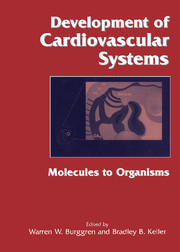Book contents
- Frontmatter
- Contents
- List of contributors
- Foreword by Constance Weinstein
- Introduction: Why study cardiovascular development?
- Part I Molecular, cellular, and integrative mechanisms determining cardiovascular development
- 1 Genetic dissection of heart development
- 2 Cardiac membrane structure and function
- 3 Development of the myocardial contractile system
- 4 Vasculogenesis and angiogenesis in the developing heart
- 5 Extracellular matrix maturation and heart formation
- 6 Endothelial cell development and its role in pathogenesis
- 7 Embryonic cardiovascular function, coupling, and maturation: A species view
- 8 Hormonal systems regulating the developing cardiovascular system
- Part II Species diversity in cardiovascular development
- Part III Environment and disease in cardiovascular development
- Epilogue: Future directions in developmental cardiovascular sciences
- References
- Systematic index
- Subject index
2 - Cardiac membrane structure and function
from Part I - Molecular, cellular, and integrative mechanisms determining cardiovascular development
Published online by Cambridge University Press: 10 May 2010
- Frontmatter
- Contents
- List of contributors
- Foreword by Constance Weinstein
- Introduction: Why study cardiovascular development?
- Part I Molecular, cellular, and integrative mechanisms determining cardiovascular development
- 1 Genetic dissection of heart development
- 2 Cardiac membrane structure and function
- 3 Development of the myocardial contractile system
- 4 Vasculogenesis and angiogenesis in the developing heart
- 5 Extracellular matrix maturation and heart formation
- 6 Endothelial cell development and its role in pathogenesis
- 7 Embryonic cardiovascular function, coupling, and maturation: A species view
- 8 Hormonal systems regulating the developing cardiovascular system
- Part II Species diversity in cardiovascular development
- Part III Environment and disease in cardiovascular development
- Epilogue: Future directions in developmental cardiovascular sciences
- References
- Systematic index
- Subject index
Summary
Cardiac function is critically dependent on the movement of ions across membranes. Contraction of the heart begins when an action potential depolarizes the plasma membrane of the myocyte, the sarcolemma. Depolarization is caused by sequential inward currents of sodium ions and calcium ions. The slow inward calcium current enters through voltagegated channels in the sarcolemma and serves several purposes. First, this current supplies a small amount of the activator calcium for binding to troponin C. Second, the sarcoplasmic reticulum (SR) takes up a considerable portion of this calcium, where it forms part of the internal store for release in subsequent contractions. Finally, this calcium triggers the release of a large amount of calcium from the SR. The released SR calcium initiates contraction by binding to troponin C, resulting in formation of cross-bridges between the myosin head and actin. Relaxation begins with the removal of calcium from the myofilaments, which is mediated primarily by the SR calcium pump but also by the Na+-Ca2+ exchanger. Removal of calcium from the myofilaments results in the breaking of actin-myosin cross-bridges and return to the resting state.
Important changes in the structure and function of cardiac membranes occur during maturation of the mammalian heart (and probably in all vertebrate hearts). These changes result in significant age-related differences in myocardial function. This chapter discusses recent work that has increased our understanding of developmental changes in cardiac membranes and of the impact of these changes on myocardial performance.
- Type
- Chapter
- Information
- Development of Cardiovascular SystemsMolecules to Organisms, pp. 18 - 26Publisher: Cambridge University PressPrint publication year: 1998



